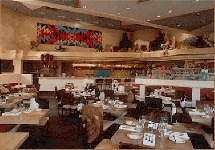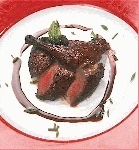SANTA FE'S COYOTE CAFE
by Louis BignamiSunset's bloody blush fades to black on the Sangre de Cristo Mountains. The scent
of cholla, chilies and piñon pines wafts in through the open window.
Flat-roofed brown adobes fade to black, and the sound of a flamenco guitar tinkles up
from the courtyard. It's dusk -- that quiet time best shared with an affectionate
companion and a cool beverage -- which separates a walker's day filled with galleries
and museums from dinner's delights. 
We could be in Southern Spain. We could be in the mountains of Mexico. We could be in an Italian Hill Town. We are in a magic spot that offers all of these, and more.
We need not identify Santa Fe, for no other town in North America offers such complex treasures of art, architecture and atmosphere. To visit Santa Fe is easy, if you allow a week, and frustrating, if you only come for three or four days. But to understand Santa Fe, and I've been visiting since 1955, you need to return, and return and return. Arrive with the realization that Santa FE is not "American." Rather think of it as a European hill town with a 400-year history that just happens to be in the Southwest where the enrichment of Native American and cowboy cultures make it unique! Unfortunately, most visitors miss the best of Santa Fe a "city for all seasons." Tourists escape summer heat here, but fewer visit in spring and fall when weather peaks and either the desert blooms, or the aspens shake golden in the wind. Winters may be the best time to visit of all as three cultures celebrate Christmas and the New Year, and there's easily accessible quite uncrowded skiing.
No matter when you visit, Santa Fe's lifestyle and, in particular, its food,
always reflected this cultural cross-fertilization. Traditional Santa Fe food wasn't
Mexican, or Spanish or Native American back in the days when Billy the Kid washed
dishes in the La Fonda Hotel. Then everyone offered theme and variations on chilies
-- spelled locally with and e, as is the traditional Spanish spelling -- that "hotted
up" corn and blue corn, tortillas, beans and tomatoes.  Contemporary restaurants now enrich these local foods with
ingredients from all over the world. At least two dozen restaurants offer solid
value, but the Coyote Café and Old House most deserve our dinner dollars, and
the Inn of Anasazi will, as the new chef takes hold, retain it's culinary status. Add
the casual offerings of Wolf Canyon and a sausage fix at the Chicago Dog and you're
only started.
Contemporary restaurants now enrich these local foods with
ingredients from all over the world. At least two dozen restaurants offer solid
value, but the Coyote Café and Old House most deserve our dinner dollars, and
the Inn of Anasazi will, as the new chef takes hold, retain it's culinary status. Add
the casual offerings of Wolf Canyon and a sausage fix at the Chicago Dog and you're
only started.
Consider the many bakeries where locals breakfast in and around the plaza. Try traditional spots like the La Fonda Hotel where the tapas are wonderful, or visit the Pink Adobe with its own cookbook and traditions. Factor in newer favorites such as the Santacafe and ethnic restaurants which serve solid Italian, French, Chinese, Japanese or even Tibetan food and artful dining in Santa Fe may take more days than most visits offer. Nobody can eat more than three meals a day. So stay longer!
Coyote Café: The Best in the Southwest 152 W. Water Street 983-1615
If you had but one meal to eat in Santa Fe, eat it at Mark Miller's Coyote Café. The overall excellence starts with the setting just a block from the Plaza. Climb up the tile stairway from West Water Street to the light; open, high ceiling restaurant 's airy ambiance, and your entertainment starts as you watch cooks perform in the open kitchen. What makes this restaurant different is that everything focuses on the food, not on the look of the plates, décor, menu prose or snotty servers.
Seating is cool and comfortable with a casual dress code. Plating seems practical rather than pretentious. So, as is too rarely the case in these days of decorative cooking, no dish looks better than it tastes, and everything looks delicious. The front of the house offers equal professionalism. Servers answer questions with specifics on any dish, and seem interested your needs, not the kitchen's. Food arrives promptly, water glasses stay filled and crumbs come off the table without effort or interruptions.
This didn't surprise me. Chef Mark Miller and his flagship restaurant have won every possible award, but the Coyote Café crew does not rest as its offerings are copied by others. Fueled by Mark Kiffin, the Executive Chef, and a herd of chefs in training and anxious for perfection, it moves forward towards Southwest cooking with an international flavor. Menus change often to reflect both Mark's search for the best ingredients which then enjoy appropriately Southwestern preparation.
Mark Miller is, of course, one of America's best known chefs. Like many he started his culinary career at Alice Water's famed Chez Panisse. Then Mark opened his Fourth Street Grill to fuel the American wood fired grill genre. After the success of his Santa Fe Bar and Grill in Berkeley, California, he relocated to Santa Fe and opened the Coyote Café a multiple award winner that's now branched out into Las Vegas.
In these days of purple menu prose it's wonderful that Coyote Café menus understate. For example, the "crispy fried soft crab" appetizer comes in a delicate golden tempura batter with a hint of green and a taste of green chile. Crabs nest on a mango-arugula salad with fermented black bean oil dressing. It's Southwestern with a wonderful combination of tastes and textures.
Such seems the case with other appetizers. Spicy wild mushroom soft tacos come dotted with grilled morels and rappini with a tomatillo sauce and roasted corn salsa. Ancho relleno is the Coyote Café's version of the often-greasy chile rellenos in soggy egg batter that infest some Mexican restaurants. Ancho rellenos come stuffed with herbed piñon pine goat cheese and roasted corn in chilies in a lighter, brighter, better, crisper batter much like tempura with a pastel hint of green chili. Pickled sweet chilies and onions add crunch and bite. Like shrimp? Try the grilled buttermilk corn cakes with chipotle shrimp and bright tasting salsa fresca as fresh tasting as its name.
Entrées are even better than the appetizers, and I could live on Coyote Café appetizers. An entrée as simple as "grilled striped bass" presents a skin-on grilled, properly firm piece of wild, not mushy mariculture, striper with a browned exterior and moist interior. This arrives on warm lentil salad with wild mushrooms and apple smoked bacon with a superb tomato essence and spring asparagus dressing. Please taste the skin: most gourmets feel it's the best part! However, Mark's ancho cherry barbecued quail broke my heart. I have always lived in quail country -- New Mexico has at least three different species, and I have eaten hundreds of quail in some of the best French and American restaurants and more quail at home. I've even written a book on game and game bird cooking, but Mark's quail beat my best.
Preparation starts with a pair of properly pan-fried quail. This requires close attention as the legs require less time to cook than the breasts. These are tossed with a bing cherry and arugla salsa and served over a lacy, light and wonderful toasted pistachio waffle. The result is sweet and sour and soft and crunchy and sharp and mild and totally wonderful. Other entrees all seemed deliciously different. Squab, a personal favorite, comes twice cooked over fermented black bean rice with a wonderful wine reduction.
